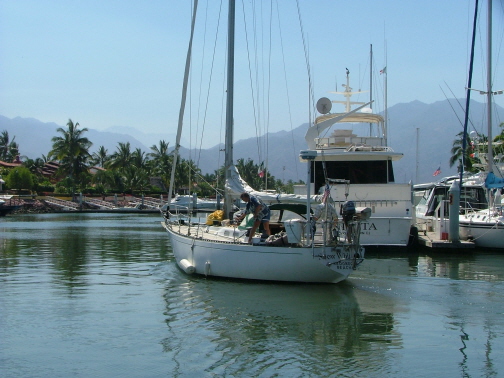
TO MAZATLAN & SAN CARLOS

Sadly, we watched our friends Hugh and Vickey of the Tartan 41, Snow White, depart Marina Vallarta, Puerto Vallarta, but we wished them a smooth passage home to Redondo Beach, California. We hoped we would be able to pay them a visit later in the year when we would be returning to Mexico from Gig Harbor.
We had spent nearly two months as slip neighbors on E-Dock and had many pleasant outings and dinners with them.
Prior to our own departure, we traded emails and phone calls with Marina Seca, the boatyard in San Carlos. We had thought that we'd have three weeks or more to get there, arriving in early June. The yard's customer service manager, Jesus (hay-soos), told us they preferred to have us there by mid-May so that their work on Kavenga would be completed by the first of June. This meant we needed to make a bee-line for San Carlos, rather than cross the Sea of Cortez and island-hop our way north.
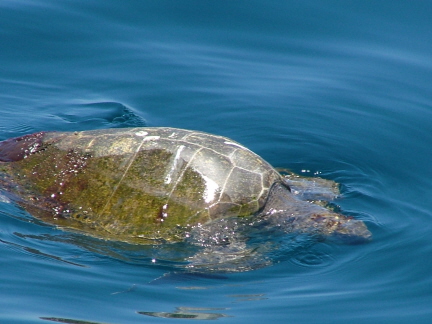
A few days after Snow White's departure, we were on our way north as well. Windless days are not good for sailing but they are perfect for sea turtle spotting.
We hardly ever saw turtles on our 1990-1991 Mexico cruise. We've seen hundreds on this one.
Apparently they do not hear well because Kavenga often came very close to them before they notice her and dive. And sometimes they dive toward her rather than away.
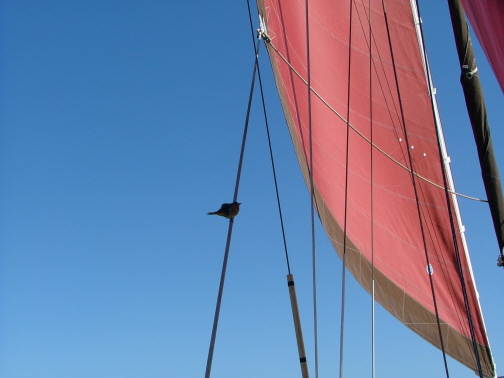
Even when we could set some sail, there was rarely enough to warrant shutting down the engine. On the way into Mazatlan, we picked up this little yellow finch. He wisely stayed with us for almost two hours and did not leave until land was within relatively easy flying distance. Our past experience with avian hitch-hikers has been that they often try to take off too soon.
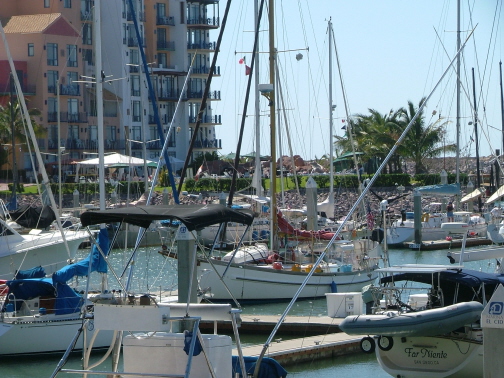
When we left Puerto Vallarta we had thought that we would stop at Isla Isabella for one night before continuing on to Mazatlan. But as we analyzed our options we realized we were going to have to do at least one overnight passage regardless whether we stopped or not.
Having spent time at Isla Isabella on our last cruise we decided to continue on direct to Mazatlan. We later learned that our friends on Snow White were anchored at Isla Isabella as we sailed by.
Here's Kavenga at El Cid Marina in Mazatlan. There's a bar at the entrance to the harbor and the sea was breaking on it when we came in. There was also a lot of surge in the marina, causing all of the boats to continuely lunge back and forth on their dock lines.
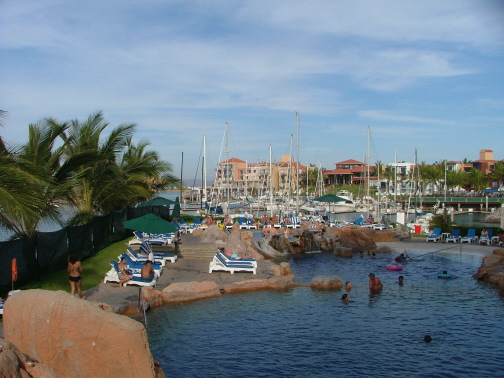
One of the benefits of staying at the El Cid Marina was the use of its great swimming pool, with its swim-through caves and waterfalls.
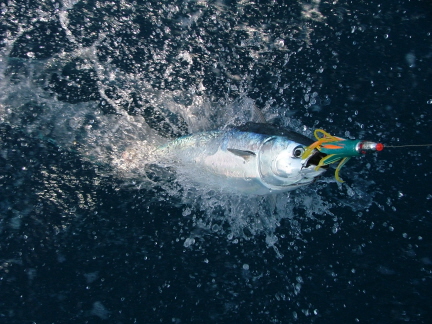
After a relatively short stay in Mazatlan, it was time for us to get back on the road to San Carlos. Unlike the Baja (west) side of the Sea of Cortez, there are hardly any good anchorages or ports of call along the mainland (east) side. Consequently we made the somewhat reluctant decision to sail direct to San Carlos, which meant we'd likely spend three days and nights underway.
Once again there was very little wind and the seas rarely exceeded 1-foot chop. Usually, the sea surface was more suitable for water skiing than sailing.
Consequently, we motored. We caught several of these bonita-type tuna. However, these species aren't great tasting so we released all that we caught and eventuallty gave up fishing because they would hit the lure within minutes of us putting it out, not giving any other species a chance.
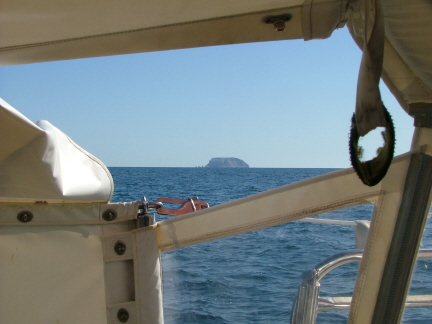
The course from Mazatlan to San Carlos was a straight shot with very little scenic coastline. This rocky island off the commerical port of Topolobampo was one of the few sights that broke up the monotony of the passage.
Those of you who are sailors might be interested to note that when we are passagemaking in hot sunny climates, we have Kavenga's cockpit almost totally shaded from the sun. In this shot you see the cockpit weather cloths in the lower left corner, the dodger in the upper right corner, an awning along the top, and a "wing panel" that connects the awning to the weather cloths (left center), partially rolled back to permit the taking of this photo. There is also a "window panel" from the dodger to the weather cloth that is for protection from wind and spray rather than sun. Over the years we have cruised, we have learned how important it is to protect yourself from the elements when you are at sea for long periods of time.
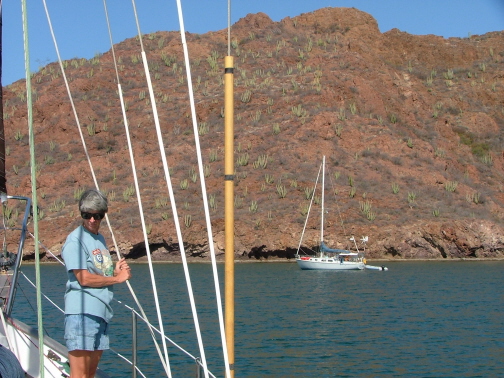
Originally we had estimated our arrival for the morning after the third night at sea. But thanks to our new Yanmar diesel engine we were able to average well over six knots for sixty-one straight hours. We arrived off the entrance to San Carlos just after sunset on the third evening but it became pitch dark with no moon almost immediately. Fortunately there is an anchorage outside the entrance with a straight-in approach. Another sailboat was anchored there and we could see their anchor light far back inside Martini Cove.
Using our radar, depthsounder and the other boat's light, we felt our way into the blackness and put out our Bruce anchor. We then got out our spotlight and noted some rocks just below the surface uncomfortably close to Kavenga's stern. An electric windlass makes the decision to weigh anchor and find a better spot an easy decision.
A beautiful landscape greeted us when we went out on deck the following morning. The surrounding hills were dotted with organ pipe, barrel, and many other varieties of cactus.
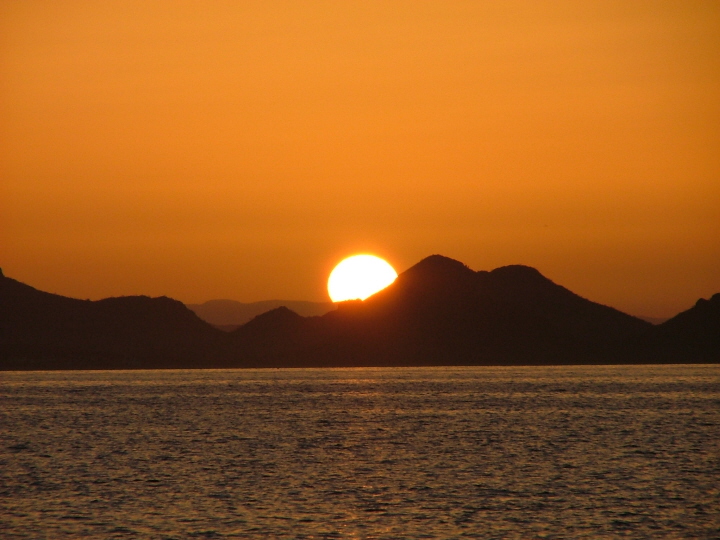
We stayed in Martini Cove one more night before moving to the main anchorage inside San Carlos harbor. This was the sunset that evening.
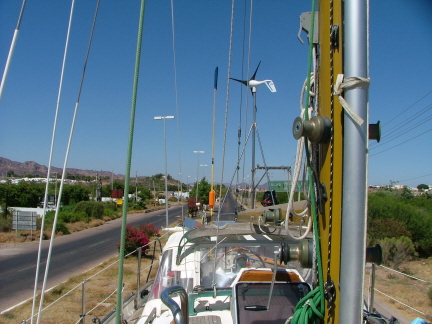
After a couple of days anchored in San Carlos harbor we had an appointment to be hauled out of the water to the Marina Seca boat yard. This was to be a first for Kavenga. For the first time she was hauled out using a specialized trailer with hydraulic arms that rose up to support her as we motored her on to the trailer's bed.
Within just a few minutes of arriving at the ramp, Kavenga was out of the water and being pushed stern first down the San Carlos - Guaymas Highway at what felt like 25 miles per hour. We were on board for the ride to the yard and it was a unique experience.

This view is from Kavenga's temporary resting spot at the far rear corner of the Marina Seca boat yard. It was here that yard workers used a sand blaster to remove 21 years worth of accumulated antifouling paint from her hull.
The landmark volcanic peaks, Tetas de Cabras can be seen in the distance.
We didn't count them, but there must have been at least 400 other boats sitting out here in the desert. The yard has a cyclone fence and concertina wire all around it, plus 24-hour watchmen, so security seemed good.
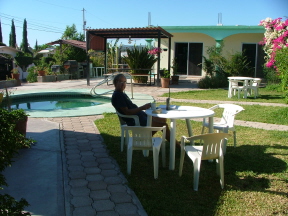 While Kavenga was in the
yard it wasn't practical for us to live aboard. We found a little
motel about two miles away called Departamentos Adlai. Besides
the pool, it had a kitchenette, two double beds, a large
bathroom, TV and air conditioning. All of this for $25 per night.
While Kavenga was in the
yard it wasn't practical for us to live aboard. We found a little
motel about two miles away called Departamentos Adlai. Besides
the pool, it had a kitchenette, two double beds, a large
bathroom, TV and air conditioning. All of this for $25 per night.
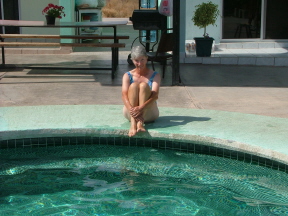
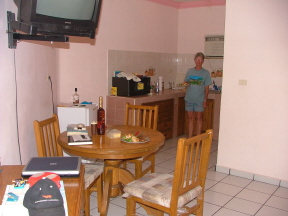
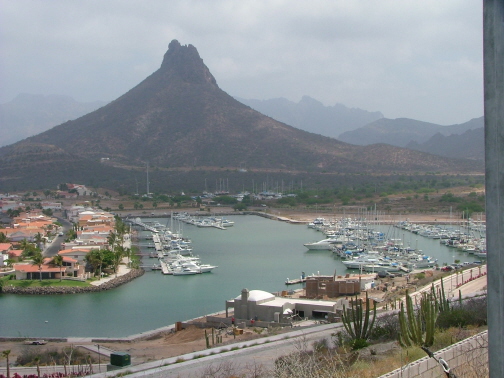
We wanted to remain in San Carlos until the boat yard had Kavenga to the point where she was ready to sit for the summer. While we waited for this work to be completed, we used our folding bikes and the local bus system to take small excursions. One of these was a fairly long bike ride out to another marina north of San Carlos, called Marina Real.
Some cruisers prefer Marina Real because it is cheaper than Marina San Carlos. However, it is quite a ways from town and there are very few services like grocery stores nearby.
It certainly is in a beautiful setting.
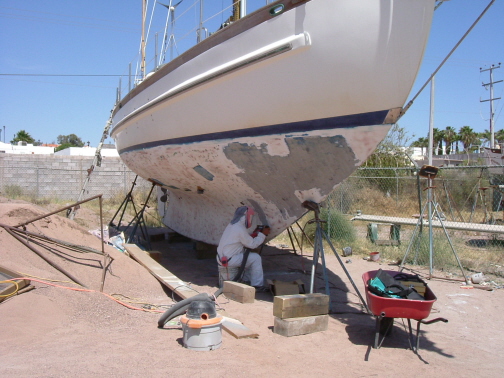
Still in the sandblast pit, the peeling process began. Jose is using a special planer that removes only the gelcoat, the white layer of pigmented fiberglass resin. The reason he's removing the gelcoat is that over the years, Kavenga developed a case of osmotic blistering--little bubbles caused by the reaction of warm seawater with chemical agents in the resin.
The solution is to remove the gelcoat, grind out and fill the blisters and then apply six coats of epoxy resin with a barrier coat additive, followed by two coats of new anti-fouling paint.
As soon as Jose finished, and Kavenga was moved into the storage yard, we checked out of the Adlai and caught a ride with friends Ron and Diane of Batwing to Tucson.
Kavenga now needs to dry out for four months in the hot summer sun. We plan to return in October before the barrier coats are applied.